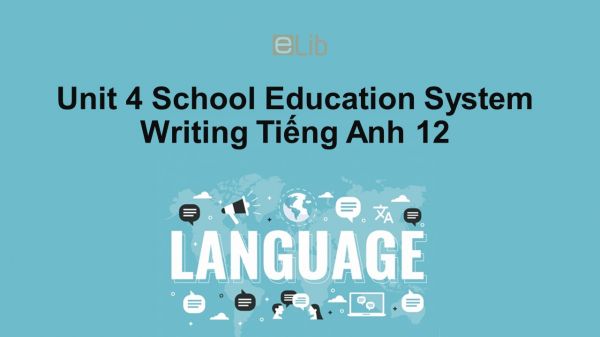Unit 4 lớp 12: School Education System-Writing
Bài học Unit 4 Lớp 12 School Education System phần Writing giúp các em rèn kỹ năng viết đoạn văn ngắn dựa theo dàn ý cho sẵn. Bài viết có liên quan đến nội dung về hệ thống giáo dục Việt Nam.
Mục lục nội dung

Unit 4 lớp 12: School Education System-Writing
1. Writing Unit 4 lớp 12
In about 150 words, write a paragraph on the formal school education system in Vietnam, using the information given in Speaking Tasks on page 47. You may follow the suggestions below (Trong 150 từ, viết một đoạn văn về hệ thống giáo dục chính quy ở Việt Nam, dùng thông tin ở Bài tập nói ở trang 47. Em có theo những lời đề nghị dưới đây)
- Levels of education: primary (5 years: start from the age of 6)
- lower secondary (4 years)
- upper secondary (3 years)
- Compulsory - education: 9 years (primary & lower secondary)
- The academic year: 35 weeks (9 months, from September to May)
- School terms: 2 terms: term 1 (Sept - Dec.), term 2 (Jan. - May)
- Time of the national examination for GCSE (early June)
Tạm dịch:
- Cấp bậc giáo dục: tiểu học (5 năm: bắt đầu từ 6 tuổi)
- trung học cơ sở (4 năm)
- trung học phổ thông (3 năm)
- Giáo dục bắt buộc: 9 năm (tiểu học và trung học cơ sở)
- Năm học: 35 tuần (9 tháng, từ tháng 9 đến tháng 5)
- Các điều khoản của trường: 2 kỳ: kỳ 1 (Tháng 9 - Tháng 12), học kỳ 2 (Tháng 1 - Tháng 5)
- Thời gian thi tuyển quốc gia cho GCSE (đầu tháng 6)
Guide to answer
The current formal school education in Vietnam consists of three levels : preschool, primary and secondary educations. Now there are two school systems in preschool and primary education in big cities: stale and private schools. In state schools, parents have to pay tuition fee. The academic year, from September to May, is divided into two semesters: from four to five months each.
Children usually start the pre-school at the age of 3, when they go to nurseries, but this stage is not compulsory. When children reach the age of 6, they must go to primary schools. The primary education last five years. When they complete their primary education, they can go to secondary schools, including Lower and Upper schools, from grade 6 to 12. However, children must pass a recruitment exam at the end of grade 9, the final year of Lower schools, to enter the upper secondary education. They will stay there until they complete grade 12. At the end of this stage, they must take the National Examination for GCSE, the requirement to go to university or college. This examination often takes place at the end of May or early June.
Tạm dịch:
Giáo dục phổ thông hiện nay ở Việt Nam bao gồm ba cấp: mầm non, giáo dục tiểu học và trung học. Hiện nay có hai hệ thống trường học trong giáo dục mầm non và giáo dục tiểu học ở các thành phố lớn: các trường công lập và tư thục. Ở các trường công lập, phụ huynh phải đóng học phí. Năm học, từ tháng 9 đến tháng 5, được chia thành hai học kỳ: từ bốn đến tháng sống mỗi kỳ.
Trẻ em thường bắt đầu đi học mẫu giáo ở tuổi lên 3, khi đi đến các nhà trẻ, nhưng giai đoạn này không bắt buộc. Khi trẻ em ở độ tuổi 6, trẻ phải đi học tiểu học. Giáo dục tiểu học kéo dài 5 năm. Khi học xong tiểu học, các em có thể vào các trường trung học, bao gồm trung học cơ sở và trung học phổ thông, từ lớp 6 đến lớp 12. Tuy nhiên, học sinh phải vượt qua kỳ thi tuyển vào cuối năm lớp 9, năm cuối của trung học cơ sở, để vào trung học phổ thông. Họ sẽ ở lại đó cho đến khi họ hoàn thành lớp 12. Khi kết thúc giai đoạn này, họ phải thi tốt nghiệp trung học phổ thông Quốc gia GCSE, đây là yêu cầu để vào đại học hoặc cao đẳng. Kỳ thi này thường diễn ra vào cuối tháng 5 hoặc đầu tháng 6.
2. Practice Task 1
Read the text and then choose the correct answer (Đọc bài văn và chọn câu trả lời đúng)
"Where is the university?" is a question that many visitors to Cambridge ask, but no one can give them a clear answer, for there is no wall to be found around the university. The university is the city. You can find the classroom buildings, libraries, museums and offices of the university all over the city. And most of its members are the students and teachers or professors of the thirty-one colleges.
Cambridge was already developing town long before the first students and teachers arrived 800 years ago. It grew up by the river Granta, as the Cam was once called. A bridge was built over the river as early as 875.
In the fourteen and fifteen centuries more and more land was used for college buildings. The town grew much faster in the nineteen century after the opening of the railway in 1845. Cambridge became a city in 1951 and now it has the population of over 100,000 many young students want to study at Cambridge. Thousands of people from all over the world come to visit the university town. It has become a famous place all round the world.
1. Why do most visitors come to Cambridge?
A. To see university.
B. To use the libraries of the university.
C. To study in the colleges in Cambridge.
D. To find the classroom buildings.
2. Around what time did the university begin to appear?
A. In the 8th century B. In the 9th century
C. In the 13th century D. In the 15th century
3. Why did people name Cambridge the"city of Cambridge"?
A. Because it was a developing town.
B. Because the river was very well - known.
C. Because there is a bridge over the Cam.
D. Because there is a river named Granta
4. From what we read, we know that Cambridge is now _______.
A. a city without wall. B. a city that may have a wall around it.
C. visited by international tourists. D. a city of growing population.
5. After which year did the town really begin developing?
A. After 800 B. After 875 C. After 1845 D. After 1945
3. Practice Task 2
Choose the correct option (Chọn đáp án đúng nhất)
1. If you want to learn a new language , you must _______ foreign language classes.
A. follow B. present C. attend D. assist
2. My favorite _______ at school is history.
A. topic B. class C. theme D. subject
3. His school report last term was very _______.
A. satisfied B. fulfilling C. satisfactory D. full
4. The students _______ to be at school by the teacher at 8 :00 am.
A. tell B. told C. have told D. were told
5. Our children _______ to school by bus every morning
A. take B. are taken C. have taken D. are taking
6. We have no seats left for the concert next Sunday
A. All the seats for the concert next Sunday have been booked
B. All the seats were sold for the concert next Sunday
C. The concert next Sunday had no seats for us
D. No seats left for us for the concert next Sunday
7. Students in public school in England have to pay _______.
A. free B. tuition fee C. fee-paying D. freedom
4. Conclusion
Qua bài học này, các em cần ghi nhớ một số từ vựng quan trọng trong bài học như sau
- formal ['fɔməl] (adj): chính quy
- formal school system in Vietnam: hệ thống giáo dục chính quy ở Việt Nam

